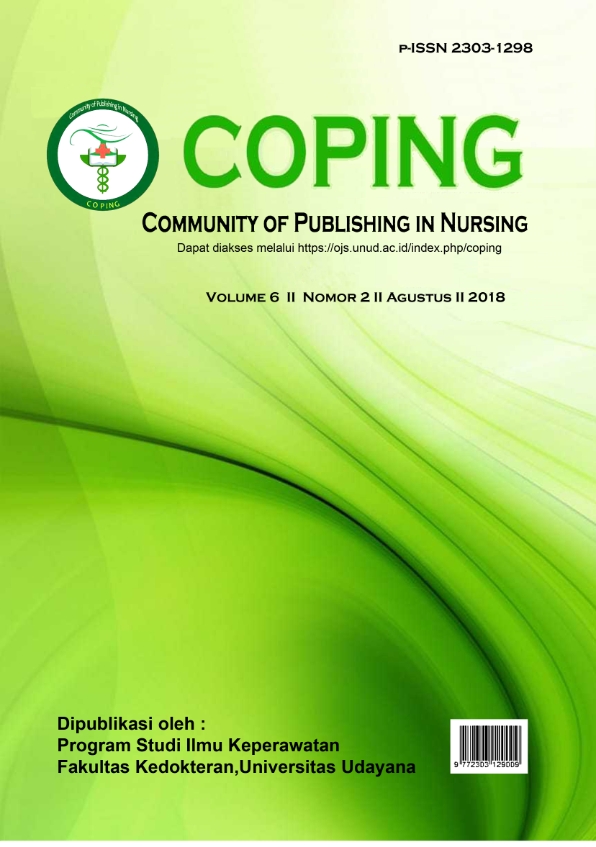Perbedaan produksi asi pada ibu dengan persalinan normal dan sectio caesarea
Abstract
Pemberian Air Susu Ibu (ASI) memberikan banyak manfaat bagi ibu dan bayi namun, di Indonesia belum dilaksanakan sepenuhnya. Beberapa ibu gagal memberikan ASI ekslusif karena merasa produksi ASI nya tidak cukup untuk bayinya. Hasil penelitian (UNICEF) tahun 2005-2011 menunjukkan bahwa bayi di Indonesia yang mendapat ASI selama 6 bulan pertama sebanyak 32% dan 50% anak diberikan ASI hingga usia 23 bulan. Faktor-faktor yang mempengaruhi produksi ASI salah satunya yaitu metode kelahiran bayi. Cara persalinan dapat mempengaruhi jumlah atau produksi ASI yang dihasilkan. Produksi ASI merupakan jumlah ASI yang keluar, serta kelancaran ASI pada ibu menyusui. Penelitian ini bertujuan untuk mengetahui perbedaan produksi asi pada ibu dengan persalinan normal dan sectio caesarea di desa Wonosari Kecamatan Patebon Kabupaten Kendal. Penelitian ini menggunakan desain deskriptif korelasi dengan pendekatan Cross-Sectional dan teknik pengambilan sampel yang digunakan yaitu Non Probability Sampel dengan Purposive Sampling dengan sampel 110 orang. Hasil analisis statistik dengan menggunakan uji Chi-Square diperoleh nilai p-value sebesar 0,006 (p<0,05) artinya terdapat perbedaan antara produksi ASI pada ibu dengan metode persalinan normal dan persalinan Sectio Caesarea di Desa Wonosari Kecamatan Patebon Kabupaten Kendal.
Kata kunci: produksi asi, persalinan normal, persalinan sectio caesare
ABSTRACT
The provision of breast milk provides many benefits for mothers and babies but, in Indonesia, it has not been fully implemented. Some mothers fail to provide exclusive breastfeeding because they feel that ASI production is not enough for their baby. Research results (UNICEF) in 2005-2011 showed that babies in Indonesia who received ASI during the first 6 months were 32% and 50% of children were breastfed until the age of 23 months. The factors that influence ASI production are one of them is the method of birth of the baby. The mode of delivery can affect the amount of production of milk produced. Breast milk production is the amount of breast milk that comes out, as well as the smoothness of breast milk in nursing mothers. This study aims to determine the differences in breast milk production in mothers with normal labor and cesarean section in the village of Wonosari, Patebon District, Kendal Regency. This study uses a descriptive correlation design with Cross-Sectional approach and the sampling technique used is Non Probability Samples with Purposive Sampling with a sample of 110 people. The results of statistical analysis using the Chi-Square test obtained a p-value of 0.006 (p <0.05), meaning that there was a difference between breast milk production in mothers with normal labor methods and Sectio Caesarea delivery in Wonosari Village, Patebon District, Kendal District.
Keywords: breastmilk production, normal delivery and delivery of sectio caesarea
Downloads
References
Atikah & Siti. (2009). Menarche Menstruasi Pertama Penuh Makna.Yogyakarta : Nuha Medika.
Charton C., Colon P., & Pla F. (2009). Shrinkage stress in light-cured composite resins : Influence of material and photoactivtion mode. J Dent Mater; 23 : 911-20
Departemen Kesehatan RI, 2011. Profil Kesehatan Indonesia tahun 2011. JakartaDepartemen Kesehatan
Desmawati. (2013). “Penentu Kecepatan Pengeluaran Air Susu Ibu Setelah Sectio Caesarea.“Artikel Penelitian Fakultas Ilmu Kesehatan UPN Veteran”. 2013: h.360-363.
Dinkes Jateng,. (2013). Upayakan Kejar Target MDG’s.
Dinas Kesehatan Kota Yogyakarta, (2014). Profil Kesehatan Yogyakarta.
Dinas Kesehatan Provinsi Jawa Tengah. (2013). Buku saku kesehatan.http : www.dinkesjatengprov.go.id di unduh 1 Juni 2015.
Indiarti. (2015). Panduan Terbaik Kehamilan, Persalinan, Dan Perawatan Bayi.Yogyakarta: Indoliterasi.
Litti, M. (2014). Hubungan Pengetahuan Ibu Hamil Tentang Resiko Sectio Caesarea Dengan Pilihan Metode Persalinan di Puskesmas Dulalowo Kecamatan Kota Tengah Kota Gorontalo. Skripsi. Universitas NegeriGorontalo.
Lucky wijaya sari. 2015. Hubungan jenis persalinan dengan onset laktasi padaibu post partum di RS PKU Muhammadiyah. Yogyakarta
Mardeyati. 2007. Hubungan Status Pekerjaan Dengan Kepatuhan Ibu Memberikan ASI Ekslusif Di RSUP DR. Sardjito Yogyakarta. http://docs.google.comJy]wer?a=v&gcache:bCDeXVKRj8oJ:arc.ugm.ac.id/fiIes/Abst (3890-H-2007).pdf.
Mulyani. (2013). Buku Ajar neonates,bayi & balita. Yogyakarta : Nuha Nedika
Notoatmodjo, S. (2007). Promosi Kesehatan Teori dan Ilmu Perilaku. Jakarta: Rineka Cipta..
Nurheti Yuliarti. (2010). Keajaiban ASI-Makanan Terbaik untukKesehatan,Kecerdasan, dan Kelincahan Si Kecil. Yogyakarta: CV. ANDI.
Padila. (2014). Buku Ajar Keperawatan Maternitas. Yogyakarta: Nuha Medika. Peraturan Pemerintah Republik Indonesia Nomor 33 Tahun 2012. Pemberian AirSusu Ibu Eksusif. Jakarta.
Prasetyono, D.S. (2009). ASI Ekslusif Pengenalan, Praktik dan Kemanfaatannya. Diva Press. Yogyakarta.
Prawirohardjo, Sarwono. (2007). Ilmu Kebidanan Jakarta: Yayasan Bina pusaka.
Prawirohardjo, Sarwono. (2010). Ilmu Kebidanan. Jakarta: YBPSP
Proverawati & Rahmawati. (2010). ASI & Menyusui. Jakarta: Nuha Medika.
Prsitiani, D. (2010). Hubungan Usia Ibu Bersalin Dengan Metode Persalinan diRumah Sakit Umum Daerah (RSUD) Koja Jakarta Utara. Skripsi.Universitas Esa Unggul.
UNICEF. (2011). ASI Eksklusif Tekan Angka Kematian Bayi Indonesia dalamhttp://situs.kesrepro.info/kia/agu/2006/kia03.htm.
Wawan, A dan M,Dewi (2010). Teori & Pengukuran Pengetahuan Sikap danPerilaku Manusia. Nuha Medika, Yogyakarta.







